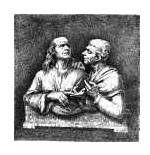Glossolalia & the Long Middle Ages

Speaking in Tongues: A Critical Historical Examination. Volume 2: Tongues Through Church History
By Philip E. Blosser and Charles A. Sullivan
Publisher: Pickwick Publications
Pages: 206
Price: $31
Review Author: Christopher Beiting
In 2023 scholars Philip E. Blosser and Charles A. Sullivan set off a “bombshell in a playground” with the publication of Volume 1 of Speaking in Tongues: A Critical Historical Examination, which I reviewed in these pages (April 2024). I am pleased to say that Volume 2 is a worthy follow-up — as good a work of scholarship as, if not better than, Volume 1. But I suspect that, for reasons I shall go into below, Volume 2 might not be as popular as Volume 1 was, or Volume 3 will be.
The three-part Speaking in Tongues project is an unusual work, not just for the conclusion it draws but also for the people who wrote it, and the approach they took to writing it. Sullivan is a Protestant and a long-time member of the Canadian Pentecostal movement, and Blosser is a Catholic convert with some exposure to — and appreciation of — the Catholic charismatic movement, though he would not describe himself as a member of it (a point of correction to my previous review, in which I misidentified Blosser as such). Thus, the approach both men take to the subject is internal rather than external and, though critical, cannot be described as hostile or adversarial.
The way the books in the series are structured is also unusual, as they go backward in time rather than forward. The authors liken it to working on an archeological dig. Volume 1 covered the present to the Reformation, Volume 2 the Reformation to the patristic era, and Volume 3 (forthcoming) the patristic era to the biblical era. Most significant is the conclusion the project draws. In Blosser and Sullivan’s words:
Anything resembling glossolalia, heavenly prayer language, or a “personal language of prayer and praise” was completely unknown in ecclesiastical writings before the nineteenth century. It was not until the nineteenth century that German Higher Critics first introduced the theory of glossolalia as unintelligible ecstatic vocalizations. Outside of the manic utterances of the second-century Montanist prophetesses and several modern sects of spiritual enthusiasts such as the Jansenist Convulsionaries, Camisards, Ranters, Shakers, and Mormons, this glossolalaic view of tongues is completely alien to the traditions of the Catholic Church and of the original Lutheran, Calvinist, Anglican reformers, and their proximate successors.
Volume 1 identifies the origins of the modern Christian practice of praying in tongues as coming from two principal sources: the Irvingite “tongues” revival in England in the 1830s and the crisis of “missionary tongues” in the early Pentecostal movement chiefly in America circa 1906-1908. In the latter movement, groups of people who were planning missionary trips to South Asia and the Far East began speaking in unintelligible tongues during prayer. They concluded that this was the work of the Holy Spirit replicating Pentecost for them by enabling them to speak Indian or Chinese languages, thus freeing them from the tedious task of actually having to learn those languages. When these missionaries finally arrived in India and China, their missionary endeavors failed miserably, since they found out they were not speaking Indian or Chinese at all. They did, however, try to save face by re-classifying their practice as a private prayer language (á la 1 Cor. 12-14), and there things have remained ever since.
Volume 2 of Speaking in Tongues picks up where Volume 1 leaves off and covers an enormous stretch of Christian history in five themed chapters. The first covers the life and activity of Jesuit missionary St. Francis Xavier (1506-1552), who had such great skill in preaching to the peoples of the Orient that he was widely believed to have had the same gift of speaking in tongues the Apostles manifested at Pentecost. Central to this section is an examination of the work of Pope Benedict XIV (r. 1740-1758), whose extensive De Servorum Dei Beatificatione et Beatorum Canonizatione (1734-1738) defending Francis Xavier provided one of the most authoritative Catholic treatments of speaking in tongues in the early modern era.
The second chapter, following on the points ultimately made by Benedict XIV, is a brief survey of the thousand years of debate by theologians on the question of whether the Apostles’ speaking in tongues at Pentecost was a miracle of speaking (i.e., were the Apostles miraculously speaking in foreign languages?) or hearing (i.e., were the Apostles speaking in Aramaic, which their hearers miraculously heard in their own language?). The consensus is that it was the former rather than the latter. The third chapter takes an in-depth look at the thought of Francisco Suárez (1548-1617) and St. Thomas Aquinas (1225-1274), whose works on the subject are considered particularly authoritative. The fourth chapter offers a similar treatment of two theologians from the patristic era: St. Augustine (354-430) and St. John Chrysostom (347-407) — again, writers considered particularly authoritative.
Blosser and Sullivan end the volume with an examination of the works of eight early patristic authors, ranging from St. Didymus the Blind (ca. 313-398) to St. Irenaeus (ca. 130-ca. 202). Though each of the authors surveyed has his own take on the subject, the broad consensus of Christian thought is consistent and clear: Speaking in tongues is a miracle involving the speaker rather than the listener, and it is a public act of communication in a foreign language, not a private act of devotion in a personal language.
Though Volume 2 is very good, it does have a few problems, particularly when compared to the previous volume. The backward moving “archeological” approach to the subject worked better in Volume 1 than it does here, simply because Volume 2 covers a much longer period of time. The chapter on St. Francis Xavier, for example, witnesses some broad jumps back and forth in time, going from Francis Xavier’s own lifetime (the early 16th century) through works of those critical of him, such as Andrew Dickson White’s famous History of the Warfare of Science with Theology in Christendom (1896), and then back to Benedict XIV (18th century) — a range of three and a half centuries. Chapter 2 covers an even longer span of time — nearly ten centuries. All this can be confusing for the casual reader who might not be familiar with some of the names involved, or who might get lost in the time shuffle.
One of the greatest strengths of Volume 2 is, at the same time, one of its greatest weaknesses: its level of scholarship. Volume 2 is excellent and very detailed — so much so that the sledding can be tough at times for the casual reader. Understanding some of the points made by individual authors can require a detailed knowledge of theology. In a couple places, Blosser and Sullivan demonstrate that particular authors’ points were misunderstood over the centuries due to bad translations of their works from Greek to Latin, and they provide clarification of what those authors actually said — in the original Greek. This is fine for readers who know Greek, but it does tend to leave the rest of us having to take their word for it.
All in all, the detail and scholarship in Volume 2 are much greater than in Volume 1, a situation that could, I fear, wind up working against it. Casual readers might end up preferring Volume 1 and Volume 3, and wind up skimming over the material in Volume 2. (One reason for doing so might simply be the irrational prejudice many have against the Middle Ages in general. Such is the curse of being a medievalist — believe me, I know it well.)
Finally, it pains me to admit that, excellent as these books are, there is one elephant in the room with regard to the Speaking in Tongues project, and it is particularly evident in this volume. Blosser and Sullivan’s overall thesis is that glossolalia, the practice of speaking in tongues as a private prayer language, was not a feature of Christianity until the 19th and 20th centuries. Strictly speaking, that is not exactly the case. In this volume, Blosser and Sullivan do mention — but do not examine in detail — groups such as the Montanists, Jansenist Convulsionaries, Camisards, Ranters, Shakers, and so on, all of whom did feature prayer traditions involving unintelligible speech. Blosser and Sullivan conclude — convincingly in my opinion — that glossolalia was never a feature of Catholicism or mainstream Protestantism. But glossolalia — or something like it — clearly was a feature of some heterodox groups.
This begs a couple thorny questions. Where do we draw the line between orthodox and heterodox Christianity? Moreover, if the practice of praying in tongues has parallels or antecedents in groups that most Christians now widely regard as heterodox, does that mean the practice of praying in tongues is itself heterodox?
Blosser and Sullivan take a gentlemanly approach to their subject, and they write with a desire not to offend the many modern charismatics who derive much spiritual benefit from the practice of praying in tongues. But what are the logical conclusions of their inquiry? Perhaps the question cannot be answered, but it does leave the reader looking forward to what the authors will cover in the forthcoming third and final volume.
©2025 New Oxford Review. All Rights Reserved.
To submit a Letter to the Editor, click here: https://www.newoxfordreview.org/contact-us/letters-to-the-editor/
You May Also Enjoy
She who shared the highs in our Lord's life shared as well in His rejection. There is a striking similarity between the indignities suffered by Mother and Son.
That our Lord meant to speak of riches as being in some sense a calamity to the Christian is plain from His praises and recommendation of poverty.
Only the risen Christ could have caused so quick and complete a transformation of sane, rational men into men they were not.

